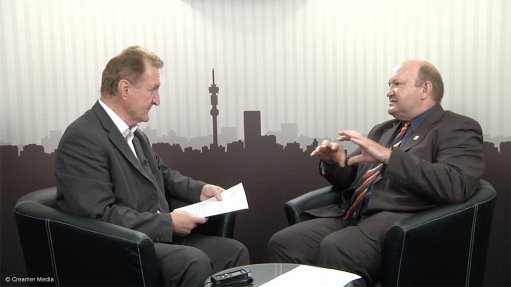
Prof Ronny Webber-Youngman (right) and Martin Creamer
Photo by: Creamer Media
JOHANNESBURG (miningweekly.com) – The University of Pretoria’s new virtual reality mine design centre, which is on track to go into test mode in April, is set to revolutionise both surface and underground mine design.
A total of R50-million is being invested in the centre, which will be put into a three-month test phase ahead of a public launch in July.
“This centre’s going to turn mining on its head,” Professor Ronny Webber-Youngman predicts in a Mining Weekly Online video interview (see attached).
The university’s mining engineering head reports that entire mines can now be designed in a virtual environment, which amplifies the consequences of bad design, enhances safety and boosts efficiency.
Although the surface mining environment has been the initial beneficiary of virtual reality mine design, scanning technology has evolved to such an extent in the last few years that underground mines can now be scanned within a matter of weeks and virtualised for design improvement.
Seventy postgraduate students are available to undertake virtual reality research projects at the University of Pretoria’s Department of Mining Engineering, where there are 337 students in all.
A course on virtual reality applications in the mining industry will be offered to second-year students from next year.
More than 1 000 students a year could potentially make use of the centre, which will also be open to University of the Witwatersrand and University of Johannesburg students.
It is envisaged as a gateway to African mining against the background of the University of Pretoria being part of the Australia-Africa Universities Network.
The University of Pretoria itself has invested R32-million in the 1 600 m2 complex and the Anglo American group company Kumba Iron Ore R18.8-million.
The facility has front row seats where entire project teams will be able to view their projects on large screens and students will have the benefit of hearing and seeing.
Hazard awareness programmes can be done in the preferred language of the listener.
As a business unit on its own, the centre will have to generate its own funds through collaborative interaction with mining companies and everything that the centre co-develops with business will be made available to students.